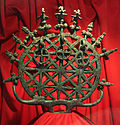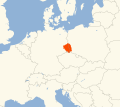The Lusatian culture existed in the later Bronze Age and early Iron Age (1300–500 BC) in most of what is now Poland and parts of the Czech Republic, Slovakia...
13 KB (1,258 words) - 13:16, 9 September 2024
covered most of today's Poland. About 650 BC, it evolved from the Lusatian culture between the lower Vistula and Parseta rivers, and subsequently expanded...
6 KB (519 words) - 12:30, 23 May 2024
and accordingly there is considerable disagreement. In Poland the Lusatian culture, spanning both the Bronze and Iron Ages, became particularly prominent...
41 KB (5,495 words) - 21:18, 22 June 2024
Tumulus culture, Nuragic culture, Terramare culture, Urnfield culture and Lusatian culture), lasting until c. 800 BC in central Europe. Arsenical bronze...
27 KB (2,968 words) - 08:44, 1 September 2024
Republic Kashubian culture Lusatian culture Polabian Slavs Culture of Poland Silesian culture Culture of Slovakia Sorbian culture Slavic folklore Egg...
868 bytes (87 words) - 15:54, 23 January 2024
Biskupin (section In popular culture)
archaeologists later confirmed it belonged to the Biskupin group of the Lusatian culture from the 8th century BC. The excavation and the reconstruction of the...
14 KB (1,349 words) - 17:24, 4 July 2024
Lusatians (people) (Sorbs) Lusatia (Sorbia) Lusatian culture, of the later Bronze Age and early Iron Age Lusatian Serbian (disambiguation), another synonym...
402 bytes (70 words) - 20:44, 14 February 2023
Sorbs (redirect from Lusatian Sorbs)
, Czech: Lužičtí Srbové, Polish: Serbołużyczanie; also known as Lusatians, Lusatian Serbs and Wends) are a West Slavic ethnic group predominantly inhabiting...
89 KB (10,093 words) - 19:58, 4 September 2024
The Tumulus culture (German: Hügelgräberkultur) was the dominant material culture in Central Europe during the Middle Bronze Age (c. 1600 to 1300 BC)...
23 KB (2,064 words) - 14:52, 1 September 2024
of the Lusatian culture is found. In Italy the late Bronze Age Canegrate and Proto-Villanovan cultures and the early Iron Age Villanovan culture show similarities...
99 KB (10,747 words) - 13:00, 29 August 2024
Cycladic culture (also known as Cycladic civilisation) was a Bronze Age culture (c. 3100–c. 1000 BC) found throughout the islands of the Cyclades in the...
14 KB (1,529 words) - 23:24, 8 September 2024
Timber-grave culture, was a Late Bronze Age 1900–1200 BC culture in the eastern part of the Pontic–Caspian steppe. It is a successor of the Yamna culture, the...
16 KB (1,622 words) - 21:21, 22 March 2024
Indus Valley Civilisation (redirect from Indus Valley Culture)
and later cultures called Early Harappan and Late Harappan in the same area. The early Harappan cultures were populated from Neolithic cultures, the earliest...
191 KB (21,640 words) - 18:39, 10 September 2024
Minoan civilization (redirect from Minoan culture)
The Minoan civilization was a Bronze Age culture which was centered on the island of Crete. Known for its monumental architecture and energetic art, it...
119 KB (14,038 words) - 11:57, 9 September 2024
entire 2nd millennium BC, (Unetice culture, Urnfield culture, Tumulus culture, Terramare culture and Lusatian culture) lasting until c. 600 BC. The Northern...
107 KB (12,210 words) - 22:56, 7 September 2024
the Jastorf culture, while the Lusatian culture of the East was succeeded by the Pomeranian culture, then in 150 BC by the Oksywie culture, and at the...
38 KB (4,601 words) - 23:36, 27 February 2024
The Hallstatt culture was the predominant Western and Central European archaeological culture of the Late Bronze Age (Hallstatt A, Hallstatt B) from the...
77 KB (8,482 words) - 21:14, 16 August 2024
in the State of Mecklenburg-Vorpommern's online catalogue. Lusatian culture Urnfield culture Nordic Bronze Age Late Bronze Age collapse Prehistoric warfare...
25 KB (2,622 words) - 21:50, 20 August 2024
Catacomb culture. In addition to the Yamnaya culture, the Catacomb culture displays links with the earlier Sredny Stog culture, the Afanasievo culture and...
28 KB (3,366 words) - 02:02, 12 July 2024
Corded Ware-related cultures: Mierzanowice, Strzyżów and Iwno. In general, the Trzciniec culture was succeeded by the Lusatian culture. The best known settlements...
10 KB (952 words) - 02:27, 28 June 2024
Various cultures occupied the area during this period and contributed to monumental stone constructions, starting with the Afanasievo culture, and continuing...
81 KB (9,910 words) - 15:49, 10 August 2024
The Andronovo culture is a collection of similar local Late Bronze Age cultures that flourished c. 2000–1150 BC, spanning from the southern Urals to the...
63 KB (7,073 words) - 09:52, 11 September 2024
Kurgan hypothesis (redirect from Kurgan culture)
prehistoric cultures, including the Yamnaya (or Pit Grave) culture and its predecessors. In the 2000s, David Anthony instead used the core Yamnaya culture and...
34 KB (3,818 words) - 02:41, 26 August 2024
The Wielbark culture (German: Wielbark-Willenberg-Kultur; Polish: Kultura wielbarska) is an Iron Age archaeological complex which flourished on the territory...
26 KB (2,866 words) - 02:07, 28 June 2024
The Ulaanzuukh culture, also Ulaanzuukh-Tevsh culture (Ch:乌兰朱和文化, c. 1450-1000 BCE), is an archaeological culture of the Late Bronze Age eastern Mongolia...
11 KB (1,186 words) - 09:55, 23 June 2024
river Elbe. It was the western periphery of the bronze and Iron Age Lusatian culture. Urns in the shape of house models were its characteristical sign....
2 KB (173 words) - 20:01, 4 March 2024
Eugene N. Borza argue that the Bryges/Phrygians were members of the Lusatian culture that migrated into the southern Balkans during the Late Bronze Age...
10 KB (1,189 words) - 16:39, 12 August 2024
Iron Age commenced c. 750–700 BC. One of the many cultures that have been uncovered, the Lusatian culture, spanned the Bronze and Iron Ages and left notable...
249 KB (28,222 words) - 01:22, 4 September 2024























